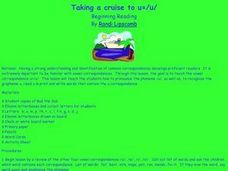Houghton Mifflin Harcourt
The Tell-Tale Heart
Here's the perfect resource for anyone using Edgar Allan Poe's famous short story the "Tell-Tale Heart." The packet includes five worksheets that provide skills practice exercises focusing on spelling with consonant blends, words with...
Starfall
Ee is for Egg
For this literacy worksheet, learners use the letter E in various contexts to increase letter recognition and spelling skills for related words.
Curated OER
The Not-So-Scary Creaky Door!
Students recognize the short vowel e in spoken language. Through listening activities, they discriminate the short vowel phoneme /e/ from other phonemes. Students associate the phoneme with its letter representation and identify the...
Curated OER
Red is My Pet!
Students complete a variety of activities related to the short /e/ sound. As a class they recite a tongue twister, and write the letter E. Students then listen to the book "Red Gets Fed," and identify the words in the story that...
Curated OER
Configuration Station #3
In this language arts worksheet, students study 6 words in a provided word bank. Students generate sentences, fill in missing words, write rhyming words and illustrate to show meaning.
Curated OER
Taking a Cruise To U=/u/
Students complete a variety of activities related to the short /u/ sound. As a class they recite a tongue twister, then spell different words containing the short /u/ using letter manipulatives. Students then read the book "Bud the...
Starfall
Ee is for Eggs
Students learn to write upper and lower case DeNelian letters Ee for this printing practice learning exercise. Students trace several examples, write letters, color, and count eggs.
Curated OER
Eerie Exits
Students recognize the short vowel e in written and spoken language. Through matching and listening activities, they discriminate the short vowel /e/ from other phonemes. Students associate the phoneme with its letter representation and...
Curated OER
Rocking Chair
Learners recognize the short vowel e in written and spoken language. Through matching activities, they discriminate the short vowel /e/ from other vowel phonemes. Students associate the /e/ with its letter representation and identify the...
Curated OER
Can You Hear the Sound?
Students recognize the short vowel e in spoken language. Through matching activities, they discriminate the short vowel /e/ from other short vowel phonemes. Students associate the phoneme with its letter representation and identify the...
Curated OER
Eddie the Egg
First graders recognize the short vowel e in written and spoken language. Through matching activities, they discriminate the short vowel /e/ from other phonemes. Students associate the phoneme with its letter representation and identify...
Curated OER
Elephants Enjoy Eating Eggs
Students recognize the short vowel e in written and spoken language. Through listening and matching activities, they discriminate the vowel sound /e/ from other phonemes. Students practice using the phoneme and letter in words by writing...
Curated OER
EA Words
Students determine if the "e" sound is long or short in words. In this language arts lesson, students practice discriminating between the long and short "e" sounds by practicing with word cards that are embedded in the lesson. This...
Curated OER
Fluency is Freedom!
Students read orally in groups of two to increase reading speed and fluency in this lesson. They read provided books which emphasize the short vowel sounds. The pairs time each others reading and offer encouragement and support as they...
Curated OER
The Old Door
Young scholars recognize the short vowel e in written and spoken language. Through listening and matching activities, they discriminate the vowel sound /e/ from other phonemes. Students identify the phoneme and letter in words and a...
Curated OER
Ehhh! Can you repeat that!
Students assess how to recognize phonemes that stand for letters creating spoken words utilizing the short vowel /e/. They associate our written language as a secret code to solve. The tongue twister "Everybody saw Eddie and the Eskimo...
Curated OER
What's Behind the Creaky Door?
First graders are introduced to the concept that letters stand for the mouth moves that we make when sounds are made. They practice making the /e/ sound and compare it to the sound a creaky door makes and then try saying the tongue...
Curated OER
Scanning Worksheet-Catullus 49
The Latin Advanced Placement Test will surely expect high schoolers to know how to scan Latin poetry. Read the additional rules provided at the top of the sheet, and then practice scanning with Catallus 49.
Alabama Learning Exchange
Phonics lesson for -ew and -oo
First graders identify letters and sounds associated with -ew and -oo sounds. Each learner receives a stack of cards containing these sounds, and they must determine whether the word uses the -ew or the -oo sound. This could easily...
Curated OER
Division of Syllables
Study diphthongs in the Spanish language. This resource contains a lot of information, so consider printing one for each learner to reference and walking them through it as a class. There is a short exercise at the bottom of the page to...
Meadows Center for Preventing Educational Risk, University of Texas at Austin
Lesson 8 - Open Syllables
Just like scholars plug something in to close a circuit, they must plug a consonant onto a word to make closed syllables. Help learners distinguish between open and closed syllables with a series of activities that emphasize open...
English To Go
Comparative and Superlative Adjectives
Who is the tallest person in your family? Are you taller than your siblings? Intermediate language learners can read over and review comparative and superlative adjectives on the first page before they jump to page two for the exercises...
Curated OER
The Imperfect (Past) Subjunctive: How?
Teach your class how to form the imperfect subjunctive. Included here is information on and examples of regular imperfect subjunctive verbs, irregular imperfect subjunctive verbs, and imperfect subjunctive -se endings displayed in long...
Curated OER
Rainbow Spelling: A Kinesthetic Approach to Encoding
Have your young learners interact with phonemes through this tactile plan! Each learner will have a colored mat where they connect different phonemes to create words. The best part is that they can self-correct easily as they spell!

























